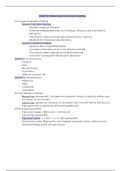Week 10: Reasoning and Decision Making
Two types of decision making:
- System 1 decision making
- Decision made on the spot
- Direct priming by stimulus (‘no thinking’): what you see is all there is
(WYSIATI)
- The solution often automatically retrieved from memory
- Excellent for most everyday decisions
- System 2 decision making
- Decision after long deliberations
- Considers information that is not directly available
- The solution often requires controlled reasoning
- Critical for consequential/long-term decisions
System 1 characteristics:
- Intuitive
- Fast
- Nonconscious
- Automatic
- Difficult to switch off
System 2 characteristics:
- Reflective
- Slow
- Conscious
- Controlled
Human decision making:
- Bruno Frey (economist): “the agent of economic theory is rational, selfish, and
his tastes do not change”
- Kahneman: people are irrational, inconsistent over time (WYSIATI), and are not
fully egocentric (importance of the group/altruism)
What would you prefer?
- Flip a coin: heads = $100; tails = nothing OR
- Sure thing: receive $46
- Expected values: ½ x 100 + ½ x 0 = $50 versus $46
- Economists prefer flipping the coin (highest expected value), while humans
overwhelmingly prefer the safe choice
,Expected value vs. expected utility
- According to Daniel Bernoulli (18th century), human choices are
not based on expected monetary values but on their
psychological value (expected utility)
- On the right is the law of diminishing returns ⇒ ⇒ ⇒
- The average utility of $100 and $0 (red) is lower than the
utility of $46 (green)
- However, a shortcoming of expected utility is that it focuses on absolute utility
instead of relative gains and losses
- ‘Today, Jack and Jill each have a wealth of 5 million. Yesterday, Jack
had 1 million and Jill had 9 million. Are they equally happy?’
- The utility is equal!
- Also, it lacks a reference point
- ‘John’s current wealth is 1 million, and Beth has 4 million. They are both
offered a choice between a gamble and a sure thing:
- Gamble: 50% chance to end up owning either 1 or 4 million
- Sure thing: own 2 million for sure’
- Equal utility, but Beth is more inclined to take the gamble: her
reference point is different (she wants to avoid loss)
- Gains and losses have equal weight (same utility with opposite sign)
- ‘Would you accept the following gamble?
- Heads: lose $100; tails: win $150’
- Most people don’t accept the gamble: they are risk
aversive. Losses are typically weighted twice as heavily a
gains
The prospect theory offers a neutral reference point for gains/losses (i.e., the
status quo). Furthermore, it considers diminishing returns (e.g., the
difference between $100 and $200 is much greater than between $900 and
$1000 - similar to utility). Lastly, gains and losses have unequal value; the
losses function is about twice as steep as the gains function
- Scenario 1: ‘you get $200 unconditionally. Then you must choose:
- p(½) = +$200; p(½) = $0 OR
- p(1) = +$100’
- Winner!
- Scenario 2: ‘you get $400 unconditionally. Then you must choose:
- p(½) = -$200; p(½) = $0 OR
- Winner!
- p(1) = -$100’
The outbreak of a disease that is expected to kill 600 people. Two
alternative programs to combat the disease:
- Scenario A:
- Program A: 200 people will be saved (72%)
, - Program B: ⅓ chance that 600 people will be saved, ⅔ chance
that no people will be saved (28%)
- Emphasizes the saving of lives (i.e., gains). Makes people risk
aversive according to prospect theory
- Scenario B:
- Program A: 400 people will die (22%)
- Program B: ⅓ chance that nobody will die, ⅔ chance that 600
people will die (78%)
- Emphasizes the loss of lives. Makes people risk-seeking
according to prospect theory
Deductive reasoning: information → conclusion; the conclusion yields new
knowledge
- Deduction: on the basis of given information we can draw a conclusion that is
definitely true (formal logic)
- Induction: on the basis of given information we can draw a conclusion that is
probably true
Different approaches to solving a problem:
- Heuristic: a rule of thumb. Generally works well, but does not guarantee a
correct answer
- Predominantly system 1
- Fast
- Commonly applied
- To inductive problems
- Sometimes to deductive problems
- Algorithm: an unambiguous description of how to solve a certain category of
problems
- Exclusively system 2
- Slow
- Not commonly applied
- Only applicable to deductive problems
Logical argument:
Conditional arguments (if… then):
- VALID:
- Modus ponens: confirmation of the antecedent
, - Modus tollens: denial of the consequent
- INVALID:
- Confirmation of the consequent
- Denial of the antecedent
Summary with examples:
Watson four-card problem: ‘IF vowel on one side, THEN even number of the other
side.’ Which cards do you have to turn over to check whether this rule applies?
Correct: E and 7; testing the rule requires falsifying
the argument
- 96% of a random sample of people made one
or more mistakes
The problem becomes easier when it gains societal
relevance/familiarity (e.g., IF you drink beer, you must be older than 18).
In conclusion, it is not concreteness per se that makes a conditional argument easy:
- A Watson 4-card problem based on ‘if I eat haddock, I drink gin’ leads again to
poor performance, even when the numbers (& letters) are substituted with
concrete examples
Familiarity with the rule seems more important:
- Permission schema - what is legal
Or the ability to apply rules for favorable social interaction:





